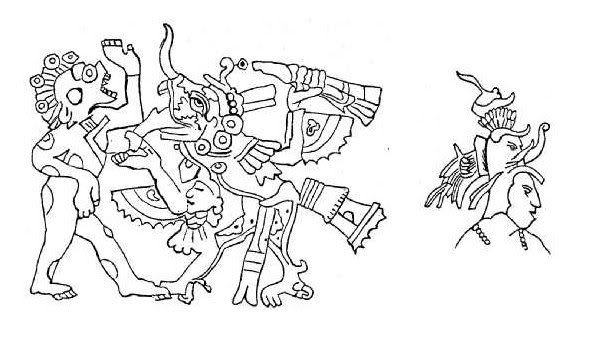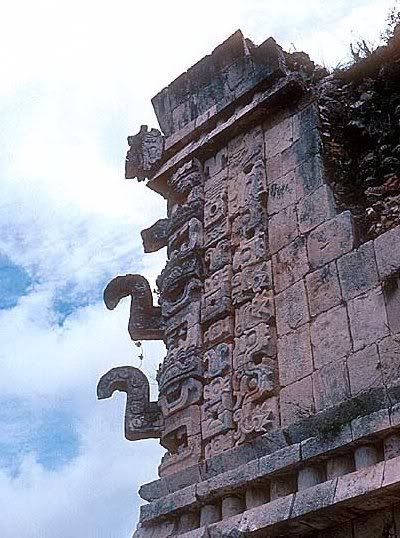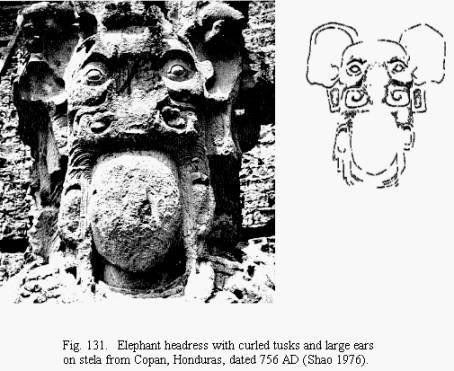|
|
Post by sordes on Feb 4, 2007 12:59:04 GMT
Yesterday I did read in a book (Dinosaurier und andere Tiere der Urzeit) that the south american gomphothere Cuvieronius became extinct as late as A.D. 400. Does anybody know further details about this? It would fit well with proposed late survival of mastodons. Another source: en.wikipedia.org/wiki/Cuvieronius |
|
Deleted
Deleted Member
Posts: 0
|
Post by Deleted on Feb 4, 2007 13:49:49 GMT
Well, I think i had postet that here anywhere.
I now of a skeleton that was found lying on a former Maya street or something like that.
That was mentioned in a book about unaccountably phenomenons (UFO's etc.) and it was said that because of the skeleton the ruins have to be older than 10000 years.
I wrote a letter to the author of the book to tell him about the holocene extinction of this Mastodon but never received an answer.
And still there are statues in parts of South-America which definitely show elephant-like animals.
Erich von Däniken said the old Indians were brought to India by aliens in their UFO's where they saw Indian Elephants and than depicted them back at home ! ;D
|
|
|
|
Post by another specialist on Feb 4, 2007 14:10:58 GMT
|
|
|
|
Post by another specialist on Oct 5, 2007 11:55:21 GMT
|
|
|
|
Post by another specialist on Oct 5, 2007 11:58:07 GMT
|
|
|
|
Post by amongthylacines on Oct 5, 2007 14:52:54 GMT
The species of the family Gomphotheriidae from South America range from the Middle Pleistocene (Ensenadan Land-mammal Age) to the latest Pleistocene, Lujanian Land-mammal Age (Alberdi & Prado 1995). These groups were descendants of a gomphothere stock from North America and arrived to South America during the 'Great Amencan Biotic Interchange' (Webb 1985), Based on vegetational distribution maps of South America during the glacial and interglacial phases, and the distribution of South American Gomphotheres, it appears that Cuvieronius inhabited an arid landscape, whereas Stegomastodon seems to have predominated in areas identified as savannah (Webb 1991 ). Cuvieronius hyodon seems to have been adapted to atemperate-cold climate, since in the intertropical zones it has been found only at the highest levels. On the contrary, in Chile it expanded to the littoral zone, that surely offered more similar living conditions, in terms of temperature, than the Andes corridor. This species would feed mainly on hard grasses, leaves, and seeds from bushy plants. Species of Stegomastodon would be better adapted to warm or temperate climatic conditions, because their most austral distribution does not surpass the 37œ S parallel in the Buenos Aires province (Tonni 1987). The frequency of Stegomastodon platensis diminishes in the Pampean Region by the latest Pleistocene, when environmental conditions became colder and drier. In lower latitudes, where Stegornostodon is more frequent, it would occupy savannahs orxerophytic pastures.
Simpson & Paula Couto (1957) considered that all South American forms must be included in one subfamily: the Anancinae, as there are only few and slight differences among them. We agree with this opinion and recognise in South America only two genera: Cuvieronius with only one species: Cuvieronius hyodon, and Stegornostodon with two species: Stegomastodon waringi and S. plotensis (Alberdi & Prado 1995). C. hyodon is geographically restricted to the Andean Region in Ecuador, Peru, Bolivia, Chile, and Northwest Argentina (Hoffstetteri 952, Casamiquela et ol. 1996). S. waringi was recorded in the Santa Elena peninsula in Ecuador (Hoffstetter 1952, Ficcarelli et 0/., 1996), and in the tropical zone of Colombia (Coireal Urrego 1981 ) and Brazil. S. platensis was recorded in the middle to latest Pleistocene in Argentina, especially the Pampean Region, and also dunngthe late Pleistocene of Uruguay (Mones & Francis 1973) and Paraguay (Cabrera 1929, Simpson & Paula Couto 1957). During the Pleistocene in South America two savannah corridors would have developed, one called 'the Andes route', or 'the height corridor' and another one the so-called 'East route' or 'plain corridor' (Webb 1978, 1985). Both corridors have special characteristics and very probably they constituted the main dispersion route for different mammal groups.
The Andes route was a more direct North-South connection and provided greater environmental homogeneity of non-woodland habitats in comparison with the East route. On the other hand, the low temperatures associated with the Andes route could have constituted a barrier for certain groups. These two corridors have conditioned the paleobiogeographic history of most North American mammals in South America. In fact, different models can be postulated for different groups depending on their capacity to produce distinct adaptive types along the duration of their dispersion process. In the case of the South American gomphotheres, the small Cuvieronius utilized the Andes corridor, whereas the large Stegomostodon dispersed through the East route (Figure I ).
We reconstruct the diets of Cuvieronius h/odon, Stegomastodon ptotensis and S. wanngi through isotopic analysis. Cuvieronius from Tarija indicates that they were almost exclusively mixed feeders. S. piatensis from the Middle Pleistocene of Argentina shows mixed feeding to browsing adaptations, and the same species from the Late Pleistocene in Argentina indicates atrend from mixed feeding to browsing adaptations. S. wanngi from the Peninsula of Santa Helena shows atrend of mixed feeding to grazing adaptations (Sanchez et o\. in press).
|
|
|
|
Post by sordes on Oct 5, 2007 15:59:52 GMT
Some time ago I found by chance a book in one of my cupboards, which was about ancient civilizations. Interestingly, I found in it photos of several old precolumabian artefacts which seems to show sculptures and engravings of mastodons.
|
|
|
|
Post by Carlos on Oct 6, 2007 10:26:41 GMT
@ amongthylacines; Very interesting text. What is the source? @ sordes: You can also see two mastodon engravings in a Maya stone in reply 5 of this thread extinctanimals.proboards22.com/index.cgi?action=display&board=sirenia&thread=1145601329&page=1BTW as the above thread deals with Holocene extinctions of all kind of mastodons in North, Central and South America, it happens that this thread is either redundant and should be merged with the older, general one, or, as more information shows up in the forum, it could be enough material to split them in (at least) three different threads on Holocene extinctions regarding each gomphothere genus, namely Mammut, Cuvieronius, Sgomastodon. A suggestion to our moderators |
|
|
|
Post by sordes on Oct 6, 2007 17:05:38 GMT
Yes Carlos, I this thread and the pictures, but thanks for the link. I will try to upload the other images. They show much more clearly something elephant-like than those stone engravings.
|
|
|
|
Post by another specialist on Dec 20, 2007 14:42:52 GMT
|
|
|
|
Post by another specialist on May 23, 2008 18:44:08 GMT
|
|
|
|
Post by sordes on Jun 7, 2008 9:04:32 GMT
Some time ago somebody in another forum wrote that he had seen some years ago also old reliefs in south america which showed clearly elephant-like animals. But sadly he had no photos.
|
|
|
|
Post by another specialist on Jun 8, 2008 9:22:38 GMT
Elephants Revisited: Many BoM critics first claim that the mention of elephants in the BoM is a laughable gaffe. When they are shown evidence for elephants in the Americas, they invariably claim it depicts nothing more than prehistoric mammoths. Click here to see pictures of mammoths and compare. This Native American pipe, is made of a light-colored sandstone, and contained evidence of grease, resin and smoke. It definitely lacks the characteristic tusks and shoulders of a mammoth. It was taken from a burial mound near an old bed of the Mississippi by the Reverend Dr. Blumer on March 2, 1880  Native American Elephant Pipe found near the Mississippi River in 1880  Carvings depicting Elephant headresses worn by Mayans at Palenque, Mexico circa 600 A.D.  Pre-Columbian Indian Burial Mound in Grant County, Wisconsin is elephant shaped. (Smithsonian Report, 1872)  Elephant Figures on ancient Mayan ruins, circa 500 AD Chichen Itza, Mexico www.the-book-of-mormon.com/photos-page3.html |
|
|
|
Post by another specialist on Jun 8, 2008 14:33:32 GMT
 Elephants in the New World? The critics point out the fact that "everyone knows" there are no elephants in the Americas... a fact that Joseph Smith should have known as well. So why would he go out on a limb and mention elephants in the Book of Mormon? Perhaps because contrary to the accepted conventional wisdom, there were small pockets of elephant-like animals (surviving Mammoths, perhaps) in the Americas? This photograph shows an interesting Mayan elephant-motif headress being worn by a human carved into a stone stela at Copan, Honduras. The carvings have been dated to approximately 756 AD. www.the-book-of-mormon.com/photos-page2.html |
|
|
|
Post by sordes on Jun 26, 2008 19:44:32 GMT
This "elephant" headdress looks to me actually more like a stylized giant bat head.
|
|
|
|
Post by sordes on Dec 2, 2010 12:23:41 GMT
Wikipedia cites a source which indicates that Cuvieronius survived at Chile at least around 9100 years B.P.: en.wikipedia.org/wiki/CuvieroniusThis is of course only very early holocene, but it prooves that this species survived the end of the Ice Age and it is well possible, that it even survived much longer. |
|
|
|
Post by surroundx on Dec 11, 2015 11:24:13 GMT
Quaternary gomphotheres (Mammalia: Proboscidea: Gomphotheriidae) from the continental shelf, Pearl Islands, PanamaAbstract Fishermen have recovered four Quaternary proboscidean teeth from the continental shelf in the vicinity of the Pearl Islands, about 50–80 km offshore from the southern coast of Panama. Two upper third molars (M3) and one lower third molar (m3) are similar to comparable teeth of the Pleistocene gomphothere Cuvieronius based on the presence of 4½ to 5½ lophs/lophids that are either horizontal or slightly inclined to long axis of the tooth and rather complicated enamel with single trefoils, incipient double trefoils, and numerous small accessory cusps. Cuvieronius is also known from the Pleistocene El Hatillo and La Trinidaíta sites from the Azuero Peninsula in Panama. The teeth of Cuvieronius from the Pearl Islands are referred to C. hyodon following recent taxonomic revisions indicating a single pan-American species of this genus was present in both North America and South America. The oldest records of Cuvieronius are from early Pleistocene (early Irvingtonian) faunas in El Salvador, Florida, and New Mexico. Cuvieronius dispersed to South America in the early Pleistocene during the Great American Biotic Interchange, with the earliest record of C. hyodon on that continent from the early to middle Pleistocene (Ensenadan) Tarija fauna in Bolivia. The two late Pleistocene populations of C. hyodon in the Neotropical region have a disjunct biogeographic distribution, with the population from southern Mexico and Central America separated from the second population in the Andean highlands of Ecuador, Peru, and Bolivia by a distance of about 1000 km. The intervening region comprising the lowland tropics of northern South America was populated by the gomphothere Notiomastodon during the late Pleistocene, although Notiomastodon is also known from Andean localities in Ecuador and Peru. Two of the Cuvieronius teeth from the Pearl Islands were recovered in nets by shrimp fisherman from depths of about 90 m, likely indicating they date to the Last Glacial Maximum between 30 and 15 ka, when sea level was as much as 120 m lower than present and the Gulf of Panama was dry land. These teeth represent the first record of late Pleistocene fossils of terrestrial mammals from the continental shelf in Central America. Source: Morgan, Gary S., McFadden, Bruce J. MacFadden and Martínez, Martín. (In Press, 2015). Quaternary gomphotheres (Mammalia: Proboscidea: Gomphotheriidae) from the continental shelf, Pearl Islands, Panama. Quaternary International. doi:10.1016/j.quaint.2015.11.003 [ Abstract]
|
|
|
|
Post by surroundx on Jan 19, 2016 14:41:54 GMT
Mothé, Dimila, Ferretti, M. P. and Avilla, L. S. (2016). The Dance of Tusks: Rediscovery of Lower Incisors in the Pan-American Proboscidean Cuvieronius hyodon Revises Incisor Evolution in Elephantimorpha. PLoS One 11(1): e0147009. [ Abstract] |
|
|
|
Post by surroundx on Mar 18, 2016 13:05:56 GMT
Pérez-Crespo, Víctor A., Prado, José L., Alberdi, Maria T., Arroyo-Cabrales, Joaquín and Johnson, Eileen. (2016). Diet and Habitat for Six American Pleistocene Proboscidean Species Using Carbon and Oxygen Stable Isotopes. Ameghiniana 53(1): 39-51. [ Abstract] |
|
|
|
Post by surroundx on Oct 4, 2016 10:00:44 GMT
"In contrast, extinction of Cuvieronius hyodon happened much earlier [than the early Holocene], and it was not related to the terminal Pleistocene event that lead the extinction of selected megafauna in South America, including Notiomastodon." Mothé, Dimila et al. (2017). Sixty years after ‘The mastodonts of Brazil’: The state of the art of South American proboscideans (Proboscidea, Gomphotheriidae). Quaternary International 443(A): 52-64. [ Abstract] |
|